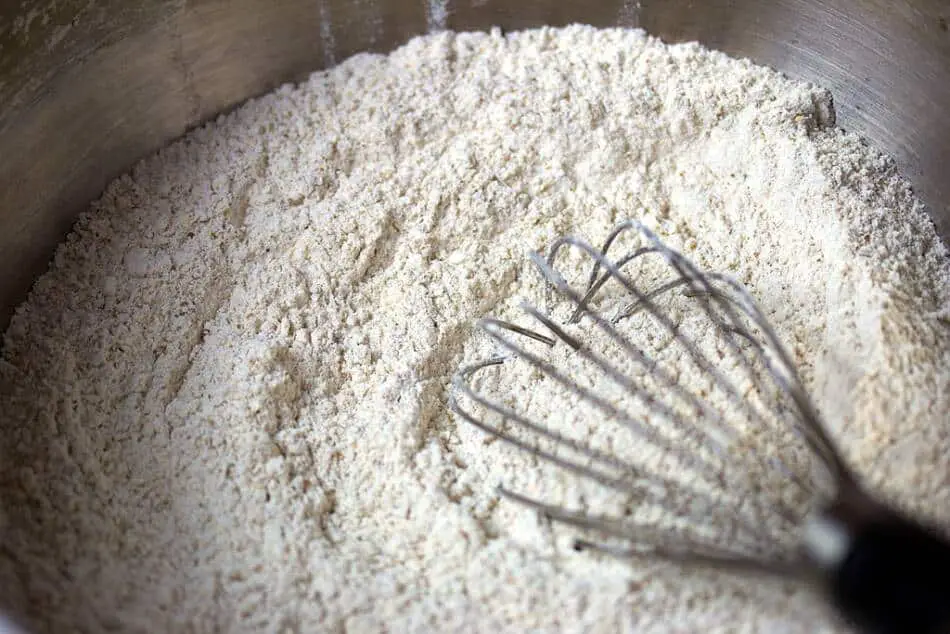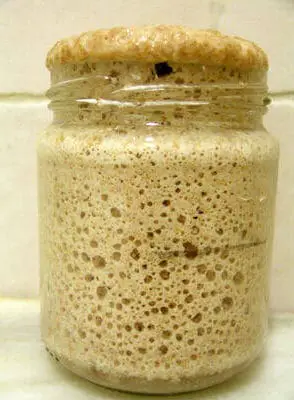The most effective ways of strengthening a weak sourdough starter is by using whole rye flour, ensuring regular feedings immediately after the sourdough starter reaches peak rise, allowing the sourdough starter to ferment at 25 Celcius, and using unchlorinated water to feed the sourdough starter.
What is a strong sourdough starter?
A strong sourdough starter will double in size in about 4-6 hours after a 1:1:1 feeding at 25 Celcius. The feeding ratio and fermentation temperature affects how quickly the sourdough starter rises, hence these parameters should be kept constant for us to determine the true strength of the sourdough starter.
A strong sourdough starter is one that has the ability to undergo fermentation vigorously to produce carbon dioxide gasses to leaven bread. The strength of a sourdough starter directly correlates to the rate of fermentation, the rate of production of carbon dioxide gasses, and to how quickly the sourdough starter rises.
A feeding ratio of 1:1:1 means each feeding will consists of 1 part sourdough starter to 1 part new flour, and 1 parts new water; 20 grams of sourdough starter is fed with 20 grams of flour and 20 grams of water.
As the feeding ratio increases to lets say 1:2:2, it will take a longer time for the sourdough starter to rise and double in size, as the concentration of wild yeast and bacteria is lower in a culture of 1:2:2 feeding than in a culture of 1:1:1 feeding.
The temperature of fermentation also greatly impacts the time at which the sourdough starter rises. The higher the fermentation temperature, the quicker the sourdough starter rises. An increase in 1-2 Celcius of fermentation temperature will cause the sourdough starter to double in size in about 1 hour quicker; a small change in temperature has a significant change in the rate of fermentation.
4 Most Impactful Ways to Strengthen your Sourdough Starter

Type of Flour: Feed using Whole Rye or Whole Wheat Flour
Whole grain flour results in a stronger sourdough starter than white grain flour. Whole rye sourdough starter in particular is superior to whole wheat sourdough starter; you can bake great bread with whole wheat starter, but bread leavened with whole rye starter will have a taller rise and a more regular crumb structure.
Flour is milled from grain kernels to varying extraction rates from about 55% to 100%. A 100% extraction rate flour is whole grain flour, where all parts of the kernel are milled and included into the flour. White flour has an extraction rate of around 70%, where most of the outer bran layer and center germ of the grain is left out.
Whole grain flour includes the outer brain layer and centre germ of the grain, which contains a high concentration of fermentative microorganisms such as wild yeast and bacteria. Whole rye flour in particular contains a higher concentration of fermentative microorganisms than whole wheat flour. Whole grain flour also contains a high amount of minerals and nutrients required for the fermentative microorganisms to flourish.
White flour made without the bran and germ of the grain has fewer fermentative microorganisms, which leads to a weaker sourdough starter culture that does not ferment as vigorously as a sourdough starter made with whole grain flour.
The sourdough starter will double in size about 1 hour quicker when using whole grain flour instead of white flour. It will also double in size about 30 mins quicker when using whole rye flour instead of whole wheat flour.
Feeding Frequency: Regular Feeding during Peak Rise
A generalized feeding schedule does not provide you with the best feeding regiment for your sourdough starter. A once a day feeding may be suitable for someone living in a colder climate, but may not be suitable for someone living in a warmer climate; the sourdough starter in the warmer climate ferments quicker, runs out of food and requires to be fed maybe two to three times a day.
I live in a warm tropical climate where the indoor temperature is about 30-31 Celcius on average on a daily basis. Contrary to the generalized advice to feed your sourdough starter once every day, my sourdough starter needs to be fed 3 times a day due to the higher temperature to keep it strong and healthy.
If I feed it less than 3 times a day, I have noticed that it starts to weaken considerably and develop a strong acidic smell. Feeding frequency varies greatly depending on the temperature of your environment.
Feeding frequency also varies depending on the age of your sourdough starter. A young sourdough starter may take a full day to reach its peak height, and as the sourdough starter matures over the course of weeks, it will take a shorter time to reach its peak height. Monitor your sourdough starter closely and take note of how long it takes to reach maximum rise, and watch as it gains strength and rises quicker after every feedings.
The best feeding frequency for your sourdough starter is when it reaches its peak height and will not rise any further if given more time. This indicates that the wild yeast and bacteria has consumed most of the food in the culture, and fermentation reaction and gas production has slowed down significantly.

Fermentation Temperature: Allow to ferment at 25 Celcius
Temperature is arguable the most important factor that determines the rate of fermentation, gas production and subsequently the time it takes for the sourdough starter to double in size. A small change in temperature have a significant impact in the rate of fermentation.
The optimum rate for wild yeast fermentation is around 25 Celcius, as the temperature increases or decreases, the rate of fermentation suffers.
However, sourdough starter also contains bacteria which ferments best at a higher temperature than wild yeast at about 30 Celcius. Similarly as the temperature increases or decreases the rate of fermentation suffers.
If the sourdough starter is allowed to ferment at a temperature much lower than 25 Celcius, the rate of fermentation will be considerably slower, and the starter will not have enough strength and vigor to be used to bake b read.
If the sourdough starter is allowed to ferment at a high temperature of about 30 Celcius, bacteria fermentation will dominate, and a considerable amount of acid will be released into the sourdough starter. At higher fermentation temperatures, the sourdough starter will tend to become too acidic.
The best temperature for fermentation would be 25 Celcius; a deviation of 1-2 Celcius is acceptable. Fermenting at this temperature ensures that the rate of fermentation is at a very high level, and fermentation is carried out by a balance between the wild yeast and acid producing bacteria.
Type of water: Unchlorinated water
Most cities in the world uses chlorine to disinfect the water supply; chlorine kills most microorganisms in the water and remains active for a long time in tap water. If chlorine is not removed from the water before it is used in your sourdough starter, it will weaken the culture.
However, using unchlorinated water will have the least impact to the strength of your sourdough starter as compared to the other methods listed above. It is still worth practicing as it definitely has some positive impact to the sourdough starter, but more importantly fine tune the type of flour that you use, the feeding frequency and fermentation temperature first.
There are 3 effective ways to remove chlorine from water:
- Leaving it uncovered overnight – chlorine dissipates through evaporation if the water is left uncovered overnight.
- Boiling the water – boiling the water speeds up the evaporation of chlorine, keep water at a full boil for about 15 minutes and allow to cool to room temperature.
- Using a carbon filter – chloramine is a sterilization chemical found in water that is harder to remove than chlorine. A carbon filter is required to deactivate chloramine in water.

